The Wrexham Industrial Estate lies in the lowland plain to the east of the city. Once a large area of Medieval hunting parkland, the area became industrialised during the second world war when factories to produce ordnance were constructed. Due to their explosive nature the factories were spread out and areas of woodland and wilder areas survived in between.
Erlas Black Wood, an ancient woodland in an urban heartland
Erlas Black Wood - Wrexham Industrial Estate (c) NWWT

Aerial image from the 1940’s of Erlas Black Wood (in the centre) surrounded by ordnance factories. Reproduced with permission.
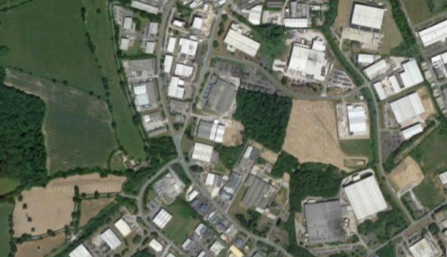
Aerial image from 2016 showing Eras Black Wood largely unchanged © Google
Even with today’s large-scale development of the area, a 2.5 hectare woodland in the heart of the estate can still be found. It is called Erlas Black Wood and is an ancient wood that has stood the test of time. Some of the trees look dead but that couldn’t be further from the truth, ecologically speaking. It is often said a tree spends half of its life growing and the other half dying. With modern woodland practices a lot of these trees are brought down before their time for various reasons. They are home to a web of life that processes wood from tough standing structures into rich soils, from fungi to beetles, millipedes to springtails. We need to think of these dying trees as factories for biodiversity, fitting within an industrial estate. Some specialists of decaying wood are rare nowadays making woodlands such as Erlas Black increasingly important for biodiversity.
This ancient woodland has some huge standing trees including Ash and Oak.
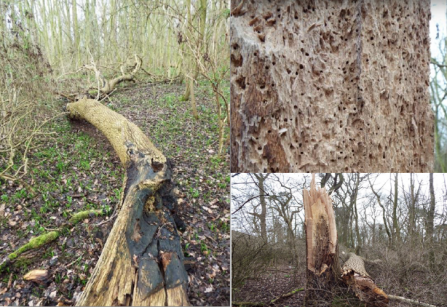
Examples of decaying wood within Erlas Black Wood © Enfys Ecology
Another feature of the wood that is rather special is the ground flora. This is made up of plants that flower in the spring to beat the oncoming shade cast by the mature canopies of the trees above. Consequently, when other habitats such as meadows and the coasts are only just waking up in spring, ancient woodlands are a riot of colour. There is a veritable carpet of delicate Wood Anemones, white Wild Garlic, pink Herb Robert, yellow Lesser Celandines, violet Dog-Violets and even areas with bright magenta Early Purple Orchids. The sight, and smell, of these woodland plants in the spring is a joy to behold and can brighten anyone’s day.
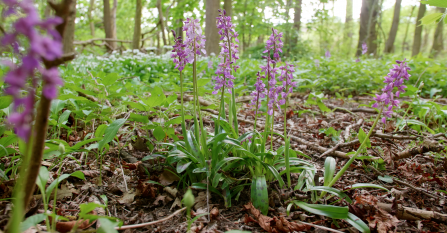
Early Purple Orchids within Erlas Black Wood © NWWT
Surrounded by all this nature, when you reach the centre of the woodland you can easily forget you are in one of Europe’s largest industrial estates. Green Woodpeckers call from a nest-site and Blackcaps sing from bushes. The hum and drum of the factories melts away. The benefits to people from spending time is nature is now well-known. During the lockdown, with time on people’s hands two-thirds of adults have spent more time in wild areas showing we do enjoy it if given the opportunity.
With factories and offices on all sides, very few people have been able to take a look around the woodland
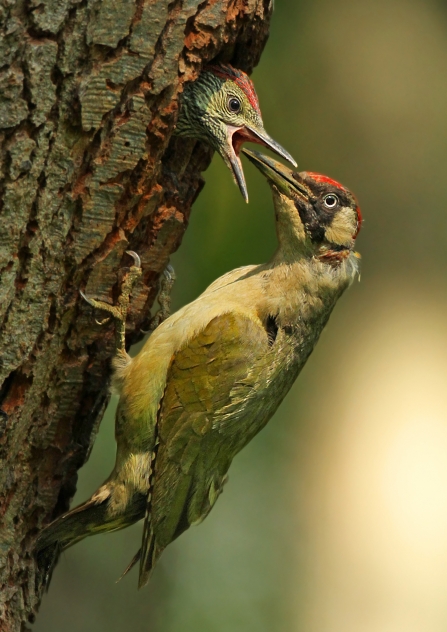
Green Woodpeckers nest within the wood © Jon Hawkins
The North Wales Wildlife Trust have leased the wood from Village Bakery, a large family-owned business on the estate, to manage and open up to the public. Under our Wrexham Industrial Estate Living Landscape project, by the end of 2020 we hope to welcome you in to walk around and take in the scene in all its glory. Having a natural space to relax in can be very important to workers and visitors to the estate and we are working to make that happen.

Erlas Black Wood is surrounded on all sides by businesses © NWWT
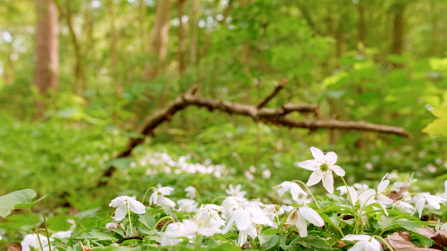
Once inside the wood it is a different world © NWWT
It is not going to be simple to open the woodland as there are challenges to overcome. We don’t want the woodland floor to be damaged and we need to make sure some of the trees are made safe. There is also the issue of an invasive non-native plant that has spread throughout early a third of the area called Snowberry. This rapidly grows into large and tangled thickets. We have begun clearing the plant which is giving the woodland floor plants enjoying more space and we can now start to plan the route for the footpath.

Problem Snowberry bushes © Kenneth Allen
By opening up this woodland under the Living Landscape project we can bring together our twin aims of improving spaces for nature and opportunities for people to enjoy it. We will keep you posted on progress so follow updates on social media, on the project webpage and in our e-newsletter, Wild Weekly. By being a member of the North Wales Wildlife Trust you also directly support the work we do in the wider landscape. Please consider joining the growing movement today.

